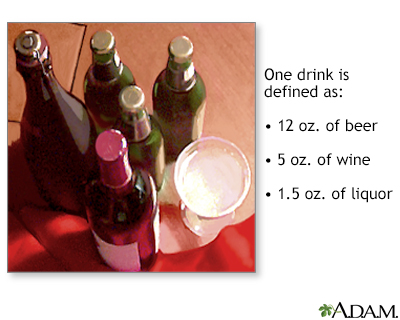Pregnancy SmartSiteTM
Alcoholism - risks; Alcohol abuse - risks; Alcohol dependence - risks; Risky drinking DescriptionBeer, wine, and liquor all contain alcohol (ethanol). Drinking an excessive amount of alcohol can put you at risk for alcohol-related problems. Definition of Alcohol UseBeer, wine, and liquor all contain alcohol. If you are drinking any of these, you are using alcohol. Your drinking patterns may vary, depending on who you are with and what you are doing. Drinking an excessive amount of alcohol can put you at risk for alcohol-related problems if:
One drink is defined as 12 ounces, oz (360 milliliters, mL) of beer, 5 oz (150 mL) of wine, or a 1 1/2-oz (45 mL) shot of liquor. Alcohol Use and Your HealthLong-term excessive alcohol use increases your chances of:
Excessive drinking can also:
Alcohol can affect your thinking and judgment each time you drink. Long-term excessive alcohol use damages brain cells. This can lead to lasting damage to your memory, thinking, and the way you behave. Damage to nerves from alcohol use can cause many problems, including:
Drinking during pregnancy can harm your growing baby. Severe birth defects or fetal alcohol syndrome (FAS) may occur. How Alcohol Use Can Affect Your LifePeople often drink to make themselves feel better or to block feelings of sadness, depression, nervousness, or worry. But alcohol can:
Families are often affected when someone in the home uses alcohol excessively. Violence and conflict in the home is much more likely when a family member uses excessive alcohol. Children who grow up in a home where alcohol is used excessively are more likely to:
Drinking too much alcohol even once can harm you or others. It can lead to any of the following:
There is no evidence that alcohol improves any aspect of your health. What You Can DoFirst, ask yourself what type of drinker you are? Even if you are a responsible drinker, drinking too much just once can be harmful. Be aware of your drinking patterns. Learn ways to cut back on drinking. If you cannot control your drinking or if your drinking is becoming harmful to yourself or others, seek help from:
ReferencesCenters for Disease Control and Prevention website. Alcohol use and your health. www.cdc.gov/alcohol/about-alcohol-use/?CDC_AAref_Val=https://www.cdc.gov/alcohol/fact-sheets/alcohol-use.htm. Updated May 15, 2024. Accessed June 18, 2024. Finnell JT. Alcohol-related disease. In: Walls RM, ed. Rosen's Emergency Medicine: Concepts and Clinical Practice. 10th ed. Philadelphia, PA: Elsevier; 2023:chap 137. National Institute on Alcohol Abuse and Alcoholism website. Alcohol's effects on the body. www.niaaa.nih.gov/alcohols-effects-health/alcohols-effects-body. Accessed February 14, 2024. National Institute on Alcohol Abuse and Alcoholism website. Understanding alcohol use disorder. www.niaaa.nih.gov/publications/brochures-and-fact-sheets/understanding-alcohol-use-disorder. Updated January 2024. Accessed February 14, 2024. O'Connor PG. Alcohol use disorders. In: Goldman L, Cooney KA, eds. Goldman-Cecil Medicine. 27th ed. Philadelphia, PA: Elsevier; 2024:chap 364. US Preventive Services Task Force. Screening and behavioral counseling interventions to reduce unhealthy alcohol use in adolescents and adults: US Preventive Services Task Force recommendation statement. JAMA. 2018;320(18):1899-1909. PMID: 30422199 pubmed.ncbi.nlm.nih.gov/30422199/. | ||
| ||
Review Date: 2/8/2024 Reviewed By: Linda J. Vorvick, MD, Clinical Professor, Department of Family Medicine, UW Medicine, School of Medicine, University of Washington, Seattle, WA. Also reviewed by David C. Dugdale, MD, Medical Director, Brenda Conaway, Editorial Director, and the A.D.A.M. Editorial team. View References The information provided herein should not be used during any medical emergency or for the diagnosis or treatment of any medical condition. A licensed medical professional should be consulted for diagnosis and treatment of any and all medical conditions. Links to other sites are provided for information only -- they do not constitute endorsements of those other sites. No warranty of any kind, either expressed or implied, is made as to the accuracy, reliability, timeliness, or correctness of any translations made by a third-party service of the information provided herein into any other language. © 1997- A.D.A.M., a business unit of Ebix, Inc. Any duplication or distribution of the information contained herein is strictly prohibited. | ||


 Alcoholism
Alcoholism Cirrhosis of the l...
Cirrhosis of the l...
